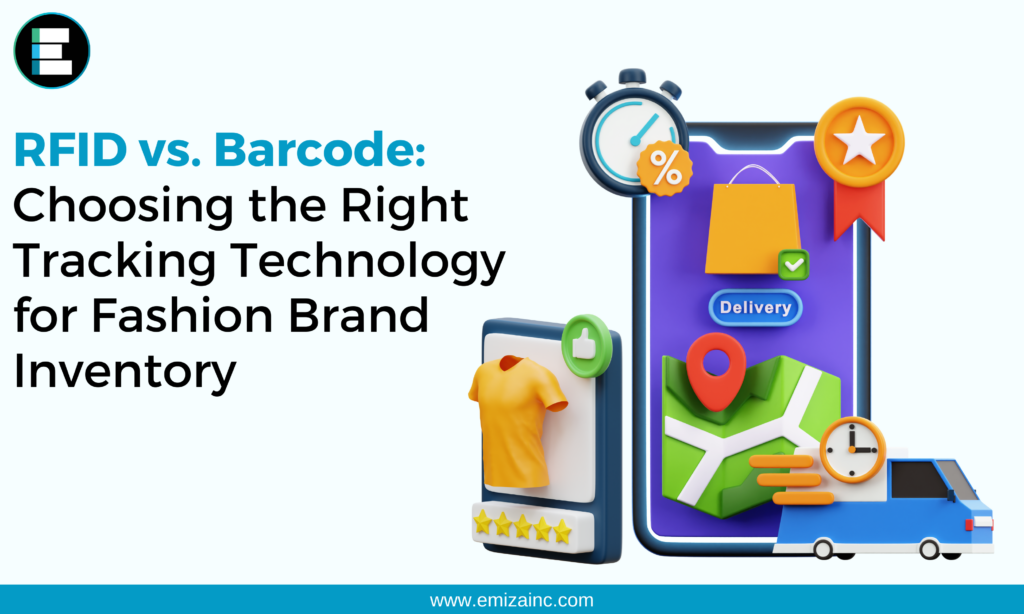Fashion brands need to keep track of their vast and ever-changing stock to ensure that the right products are available to customers when they want them. To achieve this, many fashion businesses turn to technology to streamline their inventory processes. Two popular choices are RFID (Radio Frequency Identification) and barcodes. In this blog, we’ll explore the pros and cons of each technology to help fashion brand owners make an informed decision about which tracking technology is the right fit for their inventory management needs.
Barcodes VS RFID
While barcodes have been the long-standing auto-ID technology for inventory tracking, RFID has emerged as a powerful alternative, offering significant advantages that traditional barcodes simply can’t match. Despite the numerous benefits of RFID, it’s surprising that it has not completely displaced barcodes as the predominant auto-ID technology in manufacturing and distribution.
RFID, or radio frequency identification, provides several key advantages over barcodes. One of the standout features is its ability to read labels even when they are not directly visible. Unlike barcodes, which require a clear line of sight for scanning, RFID tags can be read through materials, making them ideal for scenarios where direct visibility is challenging. Additionally, RFID allows for individual item identification rather than just identifying the type of item, enabling precise tracking and management of each unique product.
While the benefits of RFID are undeniable, the widespread adoption of this technology has been hindered by its initial cost. RFID labels, readers, and scanners are more expensive compared to barcodes and their associated equipment. However, as RFID gains acceptance and usage increases, costs have been gradually decreasing, making the technology more accessible to businesses.
RFID In Fashion Business Industry
In the fashion business, where inventory control and responsive distribution are critical, RFID has shown particular promise. Fashion products often have short life cycles, with new designs and colours constantly hitting the market. Speciality retailers need to strike a delicate balance between stocking enough of the latest trends to meet customer demand and avoiding overstocking, which can lead to inventory losses as trends change.
Here’s where RFID shines: With RFID tags on each item, fashion suppliers and distributors can gain real-time insights into product movements and inventory status. This allows for near-instantaneous replenishment of fast-moving items, specific sizes, and popular colours at each store location. Retailers can manage their inventory more efficiently, ensuring that customers find the products they want and that sales don’t slip away to competitors.
A prime example of RFID’s impact on the fashion business is the global retailer Zara. The company has embraced RFID by attaching reusable RFID tags to every item of clothing in its stores. This move has allowed Zara to respond faster to consumer preferences, ensuring the right products are available at the right time. Furthermore, RFID has enabled Zara to optimise its supply chain and reduce costs, contributing to a more efficient and profitable operation.
While RFID’s presence in the fashion business is steadily growing, widespread adoption of RFID for consumer products is still in its early stages. Some consumers have expressed concerns about the perceived intrusiveness of RFID tracking. Nonetheless, the clear benefits of RFID, especially in fashion’s fast-paced and dynamic landscape, are becoming more evident.
Let’s dive into the advantages and disadvantages of each technology to help fashion businesses make an informed choice:
RFID Pros:
- Scanning Efficiency: RFID technology can scan multiple items simultaneously, saving time and automating the inventory process.
- Optimal Inventory Control: RFID can track individual items, even when they are not visible or in motion, ensuring airtight inventory control.
- Piece-by-Piece Tracking: Each item is assigned a unique RFID, allowing for accurate tracking of high-value items or items prone to shrinkage.
RFID Cons:
- High Initial Cost: Setting up an RFID system is a significant investment as RFID tags and readers are more expensive than barcodes and barcode scanners.
- Integration Challenges: Integrating RFID data with existing inventory management systems can be complicated and costly.
- Limited Applicability: RFID may not be suitable for all businesses, especially if items are of odd sizes or if there’s a lot of metal in the scanning area.
Barcode Pros:
- Affordability: Barcodes are cost-effective, and many items come with barcodes already, saving time and resources.
- Ease of Use: Barcodes are straightforward to scan and read, with many inventory apps allowing smartphone or tablet-based scanning.
- Customizability: Businesses can generate unique barcodes for specific items, making it easier to track high-value assets or unique products.
Barcode Cons:
- Single Scanning: Barcodes can only be scanned one at a time, limiting the speed of inventory checks compared to RFID.
- Same Code for Similar Items: Barcoding may lead to confusion if all items of the same type have the same barcode, potentially causing tracking errors.
Conclusion
Ultimately, the decision between RFID and barcodes boils down to efficiency vs. expense. RFID offers advantages in tracking efficiency but comes with higher setup costs and integration challenges. On the other hand, barcodes are cost-effective, easy to implement, and may suit the needs of many fashion brands. Each fashion business should evaluate its unique needs, budget, and resources to determine which tracking technology is the best fit for its inventory management.
Ready to take your fashion business to new heights? Experience the power of “Unify” by Emiza – India’s first connected platform from checkout to delivery. Unbreak your customer experience and revolutionize your operations. Discover more at https://unify.emizainc.co

